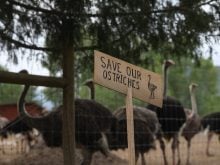Durum needs sulfur.
In a crop where nitrogen is critical, a lack of sulfur can court a cropping disaster.
“Sulfur may be one of the reasons that farmers are getting disappointing results,” said John Harapiak, of Westco Fertilizer.
Other researchers concur.
“Nitrogen may be present in adequate amounts, but without sulfur in the right ratio the plant will not make use of the nitrogen. Both yield and protein will suffer,” said Cindy Grant, a Manitoba crops researcher.
A ratio between 10 and 12 parts nitrogen to one part sulfur is necessary for cereals to make use of the nitrogen present. Sulfur is an essential component of amino acids which are the building blocks of protein. Research has shown that flour milled from sulfur deficient wheat has poor milling and baking qualities.
Read Also

VIDEO: Agritechnica Day 4: Robots and more robots, Nexat loves Canada and the trouble with tariffs
Agritechnica Day 4: Robots and more robots, Nexat loves Canada and the trouble with tariffs.
Application rate
Experts say sulfur tends to gather in lower areas in a field and can pool in places one might not expect. The result is high variability in soil samples. For that reason soil labs like to tell growers that a variant of seven to 10 pounds per acre is possible in sulfur readings.
“It is very difficult to measure sulfur accurately,” said Adrian Johnson, of Agriculture Canada.
Because of the variability in readings, a soil sample that indicates adequate sulfur levels could lead to a below average crop.
“There have been some really big durum crops taken in recent years and I think that may have helped to drain the soil of sulfur
reserves,” said Johnson.
Summerfallow rotations, heavy tillage for weed control and failing to replace nutrients used by the crop have left many clay soils without the necessary reserves of sulfur.
“Not every field will need sulfur. Some fields have saline areas that provide some sulfur. Some have some naturally occurring sulfur. But if you have problems with protein and yield and the nitrogen was there, sulfur is a good place to look for a solution to the problem,” said Harapiak.
Calculating the problem can be done through carefully made soil samples. Samples should be taken from sloping areas rather from hilltops or lower areas. A single low area can skew the sulfur reading for the entire field.
“(Last year) in cases where the sulfur was deficient enough, we saw crops that looked like they didn’t have any nitrogen placed at all,” said Johnson.
Soils with higher organic matter tend to have better sulfur levels than heavy clay soils.
“A lot of sulfur ends up as part of the straw so it tends to end up back in the soil very quickly. It will be around for awhile and subsequent crops should benefit by its addition to the fertilizer producers are applying this year,” said Grant.














